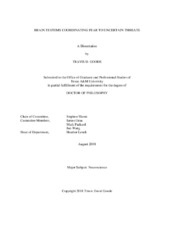| dc.description.abstract | Anxiety disorders are among the most common and debilitating forms of mental illnesses in society. Through greater understanding of the fundamental mechanisms of anxiety, as well as of the factors that lead to the persistence and relapse of fear- and anxiety-related symptoms, we may develop novel behavioral and brain techniques for intervention. Emerging evidence in humans and rodent models suggests that the bed nucleus of the stria terminalis (BNST) is a critical brain structure in the regulation and expression of fear and anxious behaviors. However, the precise contributions of the BNST to the expression and relapse of aversive learning and memory are poorly understood. Uncertainty is a key feature in anxiety disorders, and laboratory experiments suggest that the BNST may be required for processing ambiguous signals. Utilizing various modern neuroscientific techniques, including behavioral analyses, intracranial pharmacology, and immunohistochemistry, the current work explored the critical factors and boundary conditions that control BNST-dependent learning and memory. In particular, we utilized an important and clinically relevant animal model—known as Pavlovian fear conditioning, extinction, and relapse—to probe contributions of the BNST to fear- and anxiety-related defensive behaviors. These processes involved exposing rats to pairings of discrete auditory and environmental stimuli (tones and static contexts) with an aversive stimulus (footshock). Animals will come to express conditioned fear responses (defensive immobility) to the conditioned auditory and contextual stimuli alone. These fear behaviors can be extinguished by presenting the conditioned stimuli in the absence of the aversive outcome till fear subsides—relapse of conditioned behaviors can occur after after a variety of aversive triggers. In the current work, we explored the contextual factors that regulate the relapse of extinguished fear, and we identified the BNST as a critical regulator of relapse, particularly in cases where there is uncertainty of when an aversive stimulus might occur. Temporal uncertainty of an aversive outcome as an overarching factor was tested in detail, revealing a critical role for timing in the recruitment of BNST afferents to learned fears. Primary contributions of the BNST and its neural circuits to conditioned behaviors are analyzed and discussed. In total, this work suggests that temporal and contextual mechanisms, involving the BNST, may contribute to anxious symptoms and relapse. Accordingly, the BNST should be a target of possible therapeutic intervention for anxiety disorders. | en |


